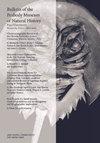博物馆收藏海绵化石中甾烷保存的前景及海绵生物标志物在分子钟中的应用
IF 0.9
4区 哲学
Q2 BIODIVERSITY CONSERVATION
引用次数: 16
摘要
海绵生物标志物假说认为,保存在新元古代岩石中的24-异丙基胆甾烷是海洋海绵留下的“分子化石”。尽管遗传学和地质学支持这一假设,但24-异丙基胆甾从未从海绵体化石中报道过。由于缺乏关于海绵生物标志物长期来源的直接证据,留下了一些悬而未决的问题,例如它们的生物合成是在海绵中进化一次还是在不同谱系中多次进化。在这项研究中,我们分析了耶鲁皮博迪自然历史博物馆收藏的10块海绵化石,以寻找甾烷生物标志物的证据。我们未能恢复24-异丙基胆甾烷,而是在所有样品中发现了几乎相同的甾烷谱。这一结果表明,化石本身几乎没有甾烷保存,再加上在收集和储存过程中人为的碳氢化合物污染。然而,来自细菌生物标志物(藿烷)的信号在不同样品中更加多样化,并且与先验预期一致,这意味着我们不能排除至少部分碳氢化合物信号是同生的可能性。我们建议未来从海绵化石中提取生物标志物碳氢化合物的尝试应在新采集的和专门制备的现场样品上进行。尽管退绵动物或它们的祖先仍然是新元古代24-异丙基胆甾烷最有可能的来源,但多种进化情况与目前的遗传和生物标志物证据一致:“海绵生物标志物”可能代表退绵动物的一种进化新异,或者是在动物树中进化得更深的一种特征。因此,我们继续确认海绵生物标志物假说的有效性,但对使用新元古代24-异丙基胆甾作为海绵分子钟的校准点持谨慎意见。相反,我们建议将其作为比较的参考点,因为新元古代之后冠状群脱海绵辐射的情景与地质记录不一致。本文章由计算机程序翻译,如有差异,请以英文原文为准。
Prospects for Sterane Preservation in Sponge Fossils from Museum Collections and the Utility of Sponge Biomarkers for Molecular Clocks
Abstract The sponge biomarker hypothesis argues that 24-isopropylcholestanes preserved in Neoproterozoic-age rocks are “molecular fossils” left behind by marine sponges. Despite genetic and geologic support for this hypothesis, 24-isopropylcholestane has never been reported from a sponge body fossil. This lack of direct evidence regarding the source of sponge biomarkers through deep time leaves unanswered questions, such as whether their biosynthesis evolved once in sponges or multiple times across different lineages. In this study, we analyzed 10 sponge fossils from the Yale Peabody Museum of Natural History collections in pursuit of evidence of sterane biomarkers. We failed to recover 24-isopropylcholestane and instead found a near-identical sterane profile across all samples. This result indicates a combination of little to no sterane preservation in the fossils themselves, coupled with anthropogenic hydrocarbon contamination during their collection and storage. However, signals from bacterial biomarkers (hopanes) were more diverse across samples and consistent with a priori expectations, meaning that we cannot rule out the possibility that at least part of the hydrocarbon signal is syngenetic. We suggest that future attempts to extract biomarker hydrocarbons from sponge fossils be performed on freshly collected and specially prepared field samples. Despite the fact that demosponges or their ancestors still present the most likely source of Neoproterozoic 24-isopropylcholestanes, multiple evolutionary scenarios are consistent with current genetic and biomarker evidence: the “sponge biomarker” could represent an evolutionary novelty in demosponges, or a trait that evolved deeper in the animal tree. We therefore continue to affirm the validity of the sponge biomarker hypothesis but caution against using Neoproterozoic 24-isopropylcholestanes as a calibration point for sponges in molecular clocks. Instead, we recommend using it as a reference point for comparison, as scenarios where crowngroup demosponges radiate after the Neoproterozoic remain inconsistent with the geologic record.
求助全文
通过发布文献求助,成功后即可免费获取论文全文。
去求助
来源期刊

Bulletin of the Peabody Museum of Natural History
BIODIVERSITY CONSERVATION-ECOLOGY
CiteScore
2.40
自引率
0.00%
发文量
6
审稿时长
>12 weeks
期刊介绍:
The Bulletin of the Peabody Museum of Natural History publishes original research based on specimens, artifacts and related materials maintained in the collections of the Yale Peabody Museum of Natural History’s curatorial divisions. The Bulletin is published twice a year, in April and October.
 求助内容:
求助内容: 应助结果提醒方式:
应助结果提醒方式:


